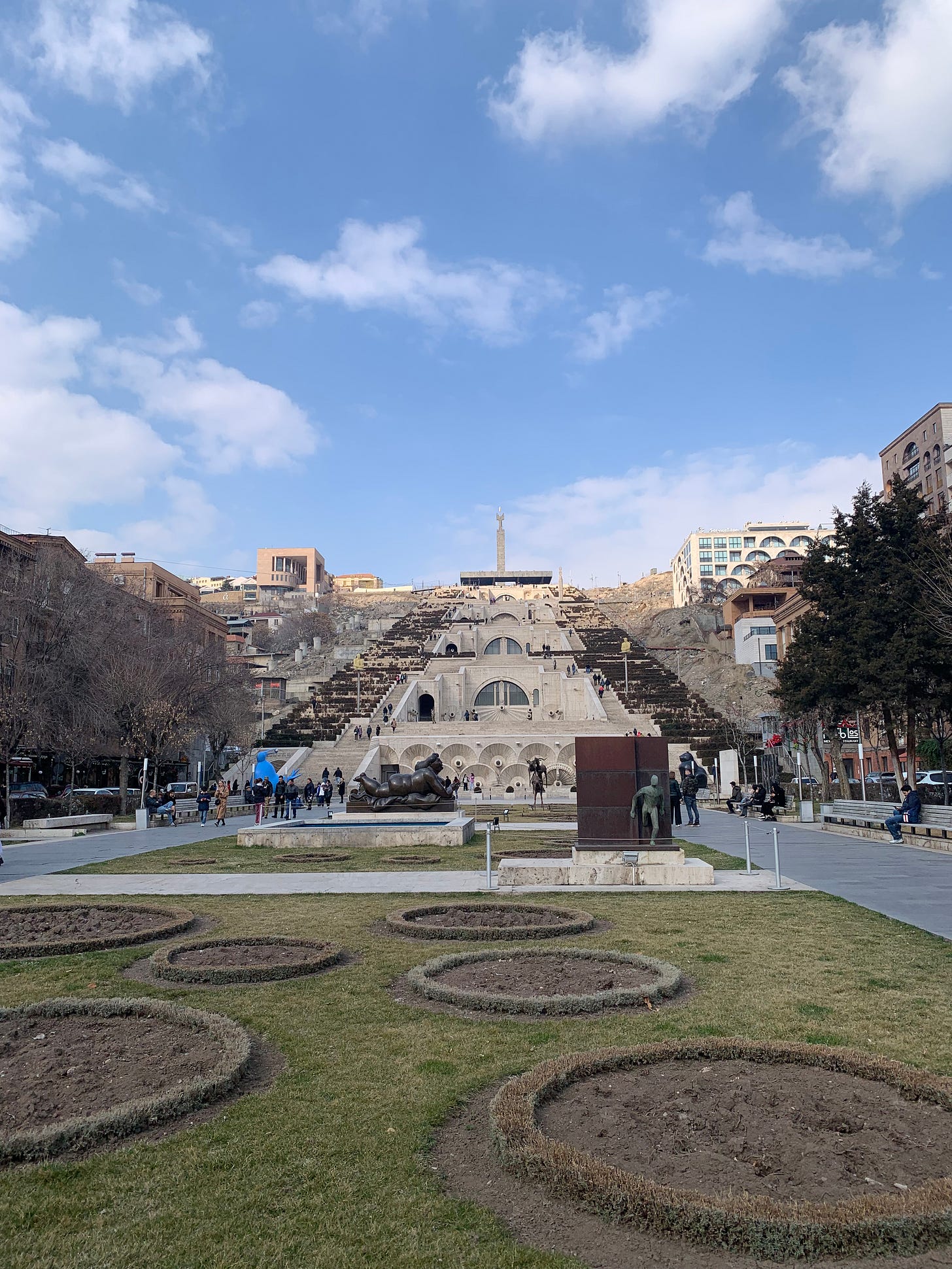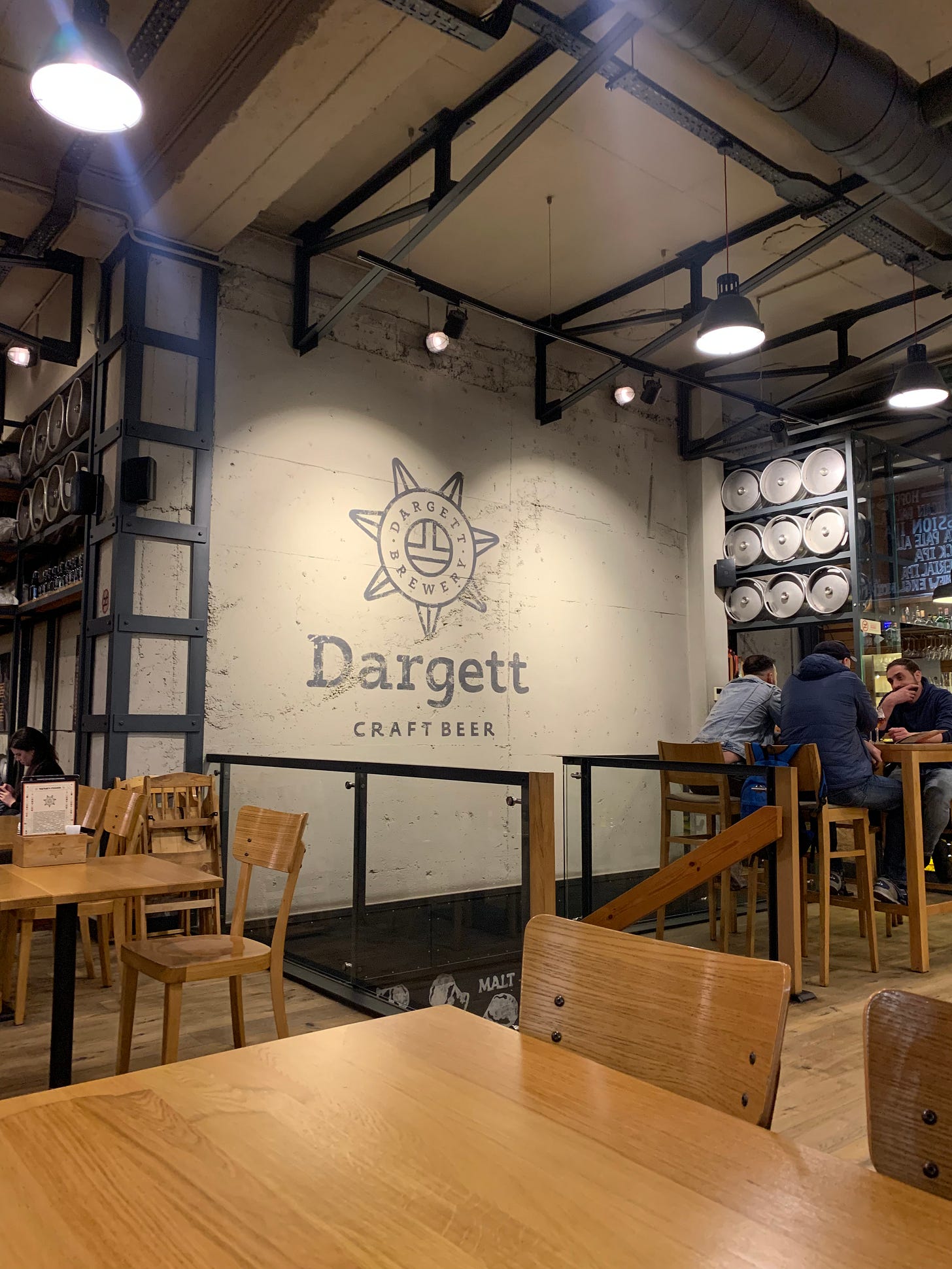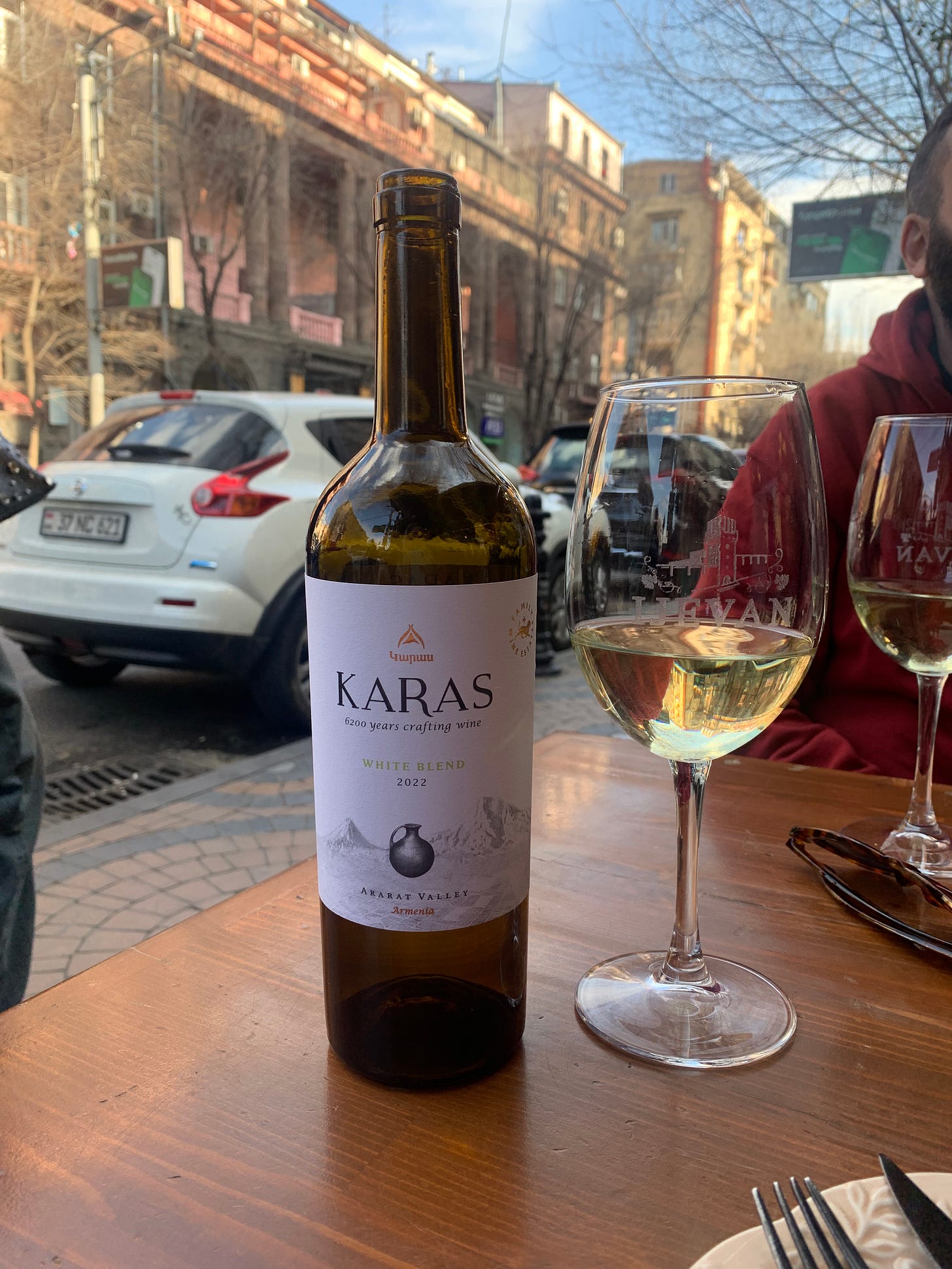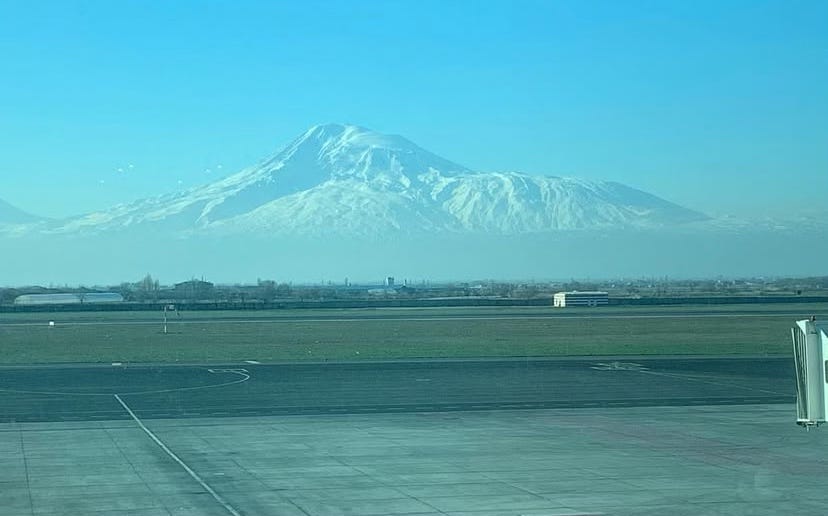Drinking Brandy in Yerevan
Under the shadow of Mount Ararat there is a thriving cocktail culture that refuses to ignore Armenian history
“My great grandfather always said: "I desire to buy a house, but I don't have the means to do it. I have the means to purchase a goat, but I don't desire it." So let us drink to our desires always meeting our capabilities” - The Caucasian Prisoner
Armenia is a country that is often more associated with The Kardashians and System of a Down, diaspora Armenians, than anything that is actually happening within its borders. It was briefly in the international news due to the displacement of over 100,000 ethnic Armenians from Nagorno-Kabarbakh (or Artsakh) in 2023 following a bloody war with Azerbaijan, Armenia otherwise doesn’t appear too much on the international stage.
Despite being little known to outsiders, Armenia is a delightful place to visit and discover, with impressive churches and cathedrals, delicious food, and a wine industry that is beginning to be recognised more and more. The people are friendly, the cities busy and handsome, the museums affordable and interesting and the countryside is genuinely stunning.
Flying into Yerevan airport you can easily get a bus (with charging ports and wifi) for a few Armenian Dram (cash only) that will drop you off on Mesrop Mashtots Avenue. This vast boulevard that cuts through the city centre is named for the originator of the Armenian alphabet and culminates in the Cascade Complex with nationally relevant artworks and beautiful views over the city (when its not too foggy).
Much like other capitals in Eastern Europe the female personification of the nation overlooks the city from a hilltop. The Mother Armenia statue carries a gigantic sword to protect her people, and to promote peace through strength and replaces a giant statue of Stalin that was removed in the 1960’s drive towards de-Stalinisation of the USSR.
When we visited I was just recovering from a bout of pneumonia which made climbing up the cascade (and any staircase high in the mountains) rather difficult, so for this reason alone I will have to go back to Armenia to see the city from a higher elevation. I’m always recovering from some lung affliction or another ever since I first got pneumonia in 2017, my lungs just can’t fight anything off now so I’m forever traipsing back to the GP for another round of antibiotics. Luckily my travelling companion Matt loves to drive in foreign countries, and so we could get to lots of the churches and higher elevations without me having to stop to cough every 3 seconds
If you have a willing driver then this is a good way to get around Armenia, the roads are mildly less terrifying than in Georgia and unless you can navigate the Marshrutka system (and feel safe being without a seatbelt in a minivan) then public transport might be a bit challenging. Tourist busses are also a possibility, but they lack the flexibility of spotting something interesting by the roadside and taking a turn to go and see it. If you are driving then be aware that at most tourist sites you’ll be expected to pay a 200 Dram fee to the parking attendant, so keep some change handy for this.
Taxis are also incredibly cheap in Armenia, with the odd ancient Lada still somehow plying their trade on the mountainous roads. Fares are not expensive, but should you wish then Yandex taxis (similar to Uber) are also widely available, but there are some concerns that the Russian government is using Yandex to keep tabs on users, even outside of Russia. Yandex allows you to choose to pay the driver in cash, so this is handy for people without a Russian bank account.
Compared to Georgia the way Russians are treated in Armenia is noticeably different. In Tbilisi graffiti everywhere compares Russians to animals, implores them to go home, and quite rightly names Putin as a war criminal. The ongoing protests in Georgia and the fury directed towards Georgian Dream shows that a lot of the population want to look westward, and there has certainly been interference in the Georgian democratic process. It’s little surprise that many Georgians want the Russians who fled the draft or disagree with the war to leave, and I felt a bit uncomfortable being greeted in Russian in Georgian shops and cafes, but as a blonde woman it’s not an unreasonable assumption that I’d be Russian in that part of the world.
In Armenia, however, Russian was understood far more widely than English and people seemed to welcome those who had chosen to settle there. We even ran into a friendly Russian sommelier in the wine aisle of a supermarket who helped us to choose some good Armenian wines to take back to our apartment. Ultimately it’s a very complicated situation involving great human pain, anger, frustration and hope, and far too complex for me to do more than observe on in this essay.
Although there are some great beer bars in Yerevan - the excellent Dargett and Ethnograph breweries make some very delicious traditional European style beers with good pub style food to eat alongside it - wine and brandy are really what Armenian drinking is all about.
Whilst the wine industry isn’t as well regarded internationally as Georgia I think that Armenia is going to make great waves in the wine world in the coming years. Wine has been produced there for millennia, and the oldest winery yet discovered was found deep in an Armenian cave system, and archaeologists have estimated the site to be over 6,000 years old. Armenian winemakers also ferment in clay amphora called karas, but that is where much of the similarities with their western neighbour ends. Due to the Soviet system of designating different republics specialists in different industries and products Georgian grapes went to making wine, and Armenian ones to brandy.
Even scientific processes were attributed to different republics. Faced with a shortage of antibiotics the soviet authorities set Georgian scientists to work isolating phages, these are viruses (often found in sewage) which can eliminate bacteria without causing any harm to humans. They are being used extensively in conditions that require lifelong antibiotic treatment such as cystic fibrosis and present an opportunity to treat diseases and combat antibiotic resistance. Today scientists are discovering more phages constantly, and the international centre of phage research is still in Tbilisi. Armenian scientists were set to work on engineering projects, and the legacy of this can be seen in the Armenian Museum of Science and Technology, as well as the chess classes that Armenian children attend as part of their state education.
Armenian Wine and Cheap Champagne
Armenian wine should not be slept on, and there are many excellent wineries making delicious and innovative wines. For my birthday we drank sparking pet nat grown in the volcanic soils at a higher elevation on the Armenian central plains. Decant wine bar in central Yerevan is an excellent spot to park yourself and work your way through a few glasses from different regions before heading out for grilled meat and lavash.
Not all wine in Armenia is excellent of course, there is cheap plonk aplenty if getting trashed and having a head splitting hangover the next day is your main concern. For me this indulgence came in the rather unusual form of $1 glasses of sparkling Armenian wine at the beautiful Yerevan Opera House. We went to see Spartacus, an Armenian ballet by composer Aram Khachaturian. It tells the story of the eponymous slave and his futile fight for freedom, in three parts, with a break between each just long enough to get a drink. Armenia Wine’s Yerevan Brut is a dry sparking wine from high elevation vineyards on the Ararat plain. Using native grapes its a refreshing and tasty glass of fizz, more than adequate to quickly knock back before going to watch some more very athletic men jump around a stage in front of the hand painted original soviet set. You can also get brandy for your interval tipple, but as a cultural experience going to the ballet or opera in Yerevan is both affordable and incredibly enjoyable. The auditorium was packed out with local families and the dancers, orchestra and conductor were all excellent, even if you don’t get 3 glasses of wine during your show it is well worth visiting.
Brandy is what Armenia really does well though, and ever since the first distillery opened in Yerevan in 1887 the stills have been producing high quality spirits made from indigenous grapes grown in the shadow of Mount Ararat. Brandy in Armenia must be aged for at least 3 years in wooden barrels to get the honey and dried fruit character intrinsic to wood aged spirits, but some are aged for far longer and command a very high price.
Ararat is the most famous Armenian brandy, and the distillery sign is visible from the road as you make your way into town from the airport. This mountain is something you will see everywhere in the country, the spiritual symbol of Armenia is on everything from the entry stamp in your passport to cigarettes and brandy. You’re more likely to see a rendering of the mountain than the actual peak in Yerevan, but if you’re lucky and the smog clears, then on some days you can see Ararat looming over the city. The fact that the mountain is now in Turkey is a source of great pain to many Armenians, as Turkey has not yet recognised the Armenian Genocide of 1915 which killed upwards of 1.5 million people. The border is now closed, although there have been some talks of opening it to foreigners, and Armenians now look from afar on lands that were once theirs. The Armenian Genocide memorial in Yerevan has unimpeded views to Ararat, and visiting this sobering site is recommended, and the emotions it invokes will stay with you long after the clouds have descended back over Ararat.
To see the mountain up close you need to drive across the plains close to the Iranian and Turkish border. The Khor Virap Monastery sits right on the border, with the Turkish side clearly visible down a steep cliff, and the mountains of Iran only a few miles away to the south. Driving up to the monastery is advisable, passing by a huge cemetery filled with large gravestones. The traditional Armenian gravestone, or khachkar, are highly decorated with crosses, religious symbols and elaborate patterns of vines and pomegranates, these stones have been given UNESCO world heritage protection, and are an incredible sight. More modern graves have full sized depictions of the deceased, and it is noticeable how many of these are of young men, depicted in their military uniform, killed in the series of wars with Azerbaijan.
Despite all this painful history, Armenians are welcoming and keen to see tourists. Whilst most of these visitors have traditionally come from neighbouring countries recent years have seen an increase in Indian and Chinese tourists, and a small increase in those coming from the West. One experience that is worth indulging in, whether you’ve seen the film or not, is going to the Caucasian Prisoner themed restaurant. This 1960’s film is a cultural phenomenon around the former USSR, with most people knowing the characters and catchphrases from the movie. The plot revolves around the old Caucuses tradition of bride kidnapping and the hapless abductors try to capture a visiting tourist (and sportswoman) and the film became one of the biggest Soviet cinema hits of all time. In Yerevan you can go to a Georgian restaurant filled with waxworks and staff recreating some of the most famous scenes from the film, and even if you have no idea whats going on it’s good fun and an experience you cannot get anywhere else.
Once you’ve filled up on heavy Caucasian food then there are many excellent cocktail bars to get a post-prandial, most of them producing riffs on classic cocktails made with Ararat brandy instead of the original spirits. These also stay open until about 2am, but it’s worth noting that in Armenia being visibly drunk on the street is very frowned upon, so it’s best to limit your cocktail intake to just a few. My favourite was Forty44 bar, with well priced and well made cocktails.
Should you feel like experiencing an Armenian dive bar then you should head to Muha, housed underneath the Writers’ Union of Armenia building, where you can take shots of woodruff or pepper vodka. Visiting to experience the loo is worth it on its own, and for any of us who spent our formative years drinking beer in repurposed Soviet buildings the nostalgia brought up by visiting this bar is quite charming.
Although I have been known to try just about any drink that’s put in front of me, I did draw the line at roadside apricot brandy. Apricots are also a symbol of Armenia, and their latin name Prunus armeniaca suggests a link, though genetic testing of the fruit seems to indicate an origin in central asia, much like apples. Along the highway between Yerevan and Lake Sevan there are stalls set up every hundred metres or so selling seabuckthorn juice, windscreen wash, and apricot brandy, all in repurposed Coke bottles. Matt did stop to try to buy some, but we decided against it at the last minute, and considering it was our last day in the country a potentially brutal hangover on a long flight home wouldn’t have been worth it. There is commercially produced apricot brandy available all over Armenia, and next time I visit I’ll be sure to try some.











